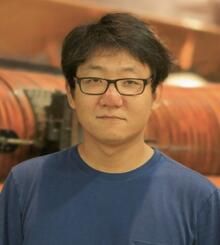
A little art, a little science
Professor's winning research photo of suspended droplets was inspired by a walk in the park

Professor's winning research photo of suspended droplets was inspired by a walk in the park
By Brian Caldwell Faculty of EngineeringA walk in the park provided inspiration for a striking photograph that earned national recognition this week for an engineering professor at the University of Waterloo.
Dr. Zhao Pan was in a 500-year-old Beijing park in his native China after a sudden rainfall when he noticed huge drops of water hanging from the tips of leaves in cypress trees.
“I play with droplets every day, but these were much larger than any I had seen in the lab,” he recalls. “I was amazed by Mother Nature, so I decided to do some research into it.”

Engineering professor Zhao Pan and a collaborator created this winning image of coloured water droplets suspended from intersecting fibres.
The net result was a 2018 study on how the angles at which fibres cross affect the volume of water droplets they can suspend, a piece of fundamental work motivated by pure curiosity.
As part of the study, Pan spent a day in the lab meticulously planning and playing with lighting, colour, backgrounds and camera settings to produce an image illustrating the findings.
All the effort paid off.

Dr. Zhao Pan of Waterloo Engineering.
Four years later, Pan and Dr. Floriane Weyer, a collaborator from the Université libre de Bruxelles in Belgium, won one of three jury prizes this week in Science Exposed.
Created by the Natural Sciences and Engineering Research Council (NSERC) of Canada, the annual contest showcases images captured by Canadian researchers in the course of their work.
Twenty finalists were chosen from hundreds of entries before the three best photographs, plus a people’s choice winner, were awarded $2,000 prizes.
“I am happy that my work communicates across the borders between disciplines,” says Pan, a professor of mechanical and mechatronics engineering. “That is the main drive for my career in research and education.”
To capture his winning image, he borrowed from Piet Mondrian, a Dutch painter and pioneer of abstract art, and shared an appreciation for those impressive drops in the park with Du Fu, an ancient Chinese poet.
Painting, poetry, science, curiosity, patience – it all came together in Composition with red, yellow, blue, green, and clear droplets, as Pan named the image.
“This picture took a long time to plan and a great deal of careful experimentation to execute,” he says. “So when it was finished, I felt satisfied, not surprised.”
Fraser King, a PhD candidate in geography at Waterloo, was also a finalist in the Science Exposed contest. His image showed a snapshot in time of a deep learning neural network’s complex brain for calculating precipitation.

Read more
Here are the people and events behind some of this year’s most compelling Waterloo stories

Read more
Waterloo Engineering community honours impact and innovation at annual awards dinner

Read more
Meet five exceptional Waterloo graduate students crossing the convocation stage as Class of 2025 valedictorians
The University of Waterloo acknowledges that much of our work takes place on the traditional territory of the Neutral, Anishinaabeg, and Haudenosaunee peoples. Our main campus is situated on the Haldimand Tract, the land granted to the Six Nations that includes six miles on each side of the Grand River. Our active work toward reconciliation takes place across our campuses through research, learning, teaching, and community building, and is co-ordinated within the Office of Indigenous Relations.